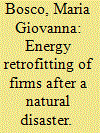|
|
|
Sort Order |
|
|
|
Items / Page
|
|
|
|
|
|
|
| Srl | Item |
| 1 |
ID:
127886


|
|
|
|
|
| Publication |
2014.
|
| Summary/Abstract |
The number of multi-family housing complexes (MFHCs) over 15 yr old in South Korea is expected to exceed 5 million by 2015. Accordingly, the demand for energy retrofit in the deteriorating MFHCs is rapidly increasing. This study aimed to develop a decision support model for establishing the optimal energy retrofit strategy for existing MFHCs. It can provide clear criteria for establishing the carbon emissions reduction target (CERT) and allow efficient budget allocation for conducting the energy retrofit. The CERT for "S" MFHC, one of MFHCs located in Seoul, as a case study, was set at 23.0% (electricity) and 27.9% (gas energy). In the economic and environmental assessment, it was determined that scenario #12 was the optimal scenario (ranked second with regard to NPV40 (net present value at year 40) and third with regard to SIR40 (saving to investment ratio at year 40). The proposed model could be useful for owners, construction managers, or policymakers in charge of establishing energy retrofit strategy for existing MFHCs. It could allow contractors in a competitive bidding process to rationally establish the CERT and select the optimal energy retrofit strategy. It can be also applied to any other country or sector in a global environment.
|
|
|
|
|
|
|
|
|
|
|
|
|
|
|
|
| 2 |
ID:
163526


|
|
|
|
|
| Summary/Abstract |
Canada has numerous climatic and geographical regions and the Canadian housing stock (CHS) is diversified in terms of vintage, geometry, construction materials, envelope, occupancy, energy sources and heating, ventilation and air conditioning system and equipment. Therefore, strategies to achieve net zero energy (NZE) status with the current stock of houses need to be devised considering the unique characteristics of the housing stock, the economic conditions and energy mix available in each region. Identifying and assessing pathways for converting existing houses to NZE buildings at the housing stock level is a complex and multifaceted problem and requires extensive analysis on the impact of energy efficiency and renewable/alternative energy technology retrofits on the energy use and GHG emissions of households.
|
|
|
|
|
|
|
|
|
|
|
|
|
|
|
|
| 3 |
ID:
166981


|
|
|
|
|
| Summary/Abstract |
Comprehensive energy retrofits by households and housing companies have been recognised as important means for emission reductions. However, the diffusion of comprehensive energy retrofits has not been as fluent as expected. In this article, we study the Finnish energy retrofit market and comprehensive energy retrofit acquisition process through participant observation and interview methods in order to better understand the work that housing companies, as potential adopters, must carry out. The results of our study suggest that to operate in the current market, adopters must expend a considerable amount of effort in finding market actors, understanding the offerings and coming to grips with what kind of energy system would be ideal for their site. Only a handful of market actors are able to help adopters in this work and even these were difficult to locate due to their position in the energy retrofit market ecology. The study indicates that future policy should foster matchmaking between potential adopters and energy counselling services and support tighter collaboration between public and private energy sector actors.
|
|
|
|
|
|
|
|
|
|
|
|
|
|
|
|
| 4 |
ID:
191317


|
|
|
|
|
| Summary/Abstract |
In 2012, an earthquake struck one of Italy's most productive and dynamic areas, the Emilia-Romagna region. Just as policy makers are today considering green and climate-conscious investments to recover from the COVID-19 pandemic, in 2012, the regional government granted specific energy retrofitting contributions to manufacturing and service firms affected by the seismic event. Through a panel data analysis, we evaluate the impact of such energy policy measures on firm-level labour productivity to assess the presence of non-zero multipliers. We find that energy retrofitting through regional aids positively affected firms' labour productivity. We discuss the energy and economic policy implications of such intervention in the current framework of fiscal recovery packages.
|
|
|
|
|
|
|
|
|
|
|
|
|
|
|
|
| 5 |
ID:
176677


|
|
|
|
|
| Summary/Abstract |
The current paper analyses the issue of energy retrofitting of buildings in Italian cities. In particular a mixed-method approach is used combining the socio-spatial analysis of data on the most relevant policy tool, namely tax deduction, together with qualitative analysis of three case studies of middle-sized cities. The results show that on the one hand tax deduction has not been very effective in promoting a deep renovation of buildings and it may exacerbate already existing inequalities. On the other hand, it emerges that progress in eco-retrofit of buildings depends mainly on creation of new intermediators and intermediation incentives. They are increasingly necessary in an urban panorama that has become inevitably polycentric.
|
|
|
|
|
|
|
|
|
|
|
|
|
|
|
|
| 6 |
ID:
150363


|
|
|
|
|
| Summary/Abstract |
The social-class dimension of energy consumption has been rather neglected relative to other theoretical approaches to energy use, despite its potential deployment in energy policies. This paper aims at investigating energy policy-related inequalities across social classes with respect to three dimensions highlighted by environmental-justice theories: income distribution, procedures producing unequal distributional outcomes, and cultural and political recognition of vulnerable and marginalised social groups. These inequalities can be exacerbated or reduced by social diffusion processes, both vertical and horizontal. These processes include policy instruments intending to lower energy consumption in the residential sector. To empirically ground the analysis, two countries with contrasting patterns of income inequalities, Portugal and Belgium, are compared on the basis of qualitative data collected in 2009–2011. We discuss the relevance of integrating the social diffusion dimension in energy policies and propose several policy instruments to do so. One of our main contribution is to argue that both vertical and horizontal diffusion across social classes, if adequately translated into policy instruments, can boost the uptake of residential energy retrofits and other energy saving practices.
|
|
|
|
|
|
|
|
|
|
|
|
|
|
|
|
|
|
|
|
|